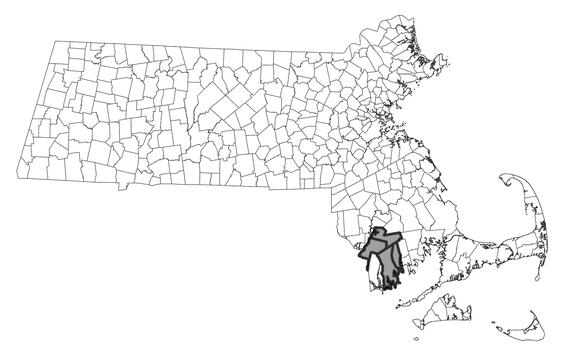- Scientific name: Juncus debilis
- Species of Greatest Conservation Need (MA State Wildlife Action Plan)
- Endangered (MA Endangered Species Act)
Description
The weak rush (Juncus debilis) is a small, inconspicuous, perennial herb from about 10-25 cm (3.5-10 in) tall. It produces erect tufts of round stems, and its maroon or dark green leaves are also round in cross-section and appear somewhat needle-like. The small, brownish flowers of this plant are borne in clusters or “glomerules” near the tops of the stems.
The weak rush is a “true” rush (unlike plants that share similar common names, such as bulrushes and spike-rushes) and belongs to the rush family (Juncaceae). Rushes in the genus Juncus are distinguished by their small, brown or green flowers, which have six tepals (three sepals and three petals that all look alike). They are also characterized by having dry fruit that splits open (a capsule) along three sutures. The weak rush belongs to a group of rushes that have round leaves with small cross-partitions (called septae) that can be felt as small bumps when running two fingers up a leaf. The weak rush can be distinguished from other members of this group by a combination of characters including its yellow-brown seeds which lack white, tail-like appendages; the elliptic capsule that exceeds (is taller than) the straw-colored tepals of each flower; and by the arrangement of the flowers into terminal clusters that are not round, but rather v-shaped (ob-pyramidal).
Members of this genus are difficult to distinguish from one another, and the weak rush superficially resembles many other rushes. A technical manual should be used to identify the different species of rushes. Common rushes that have been observed growing in the same habitat as the weak rush include the Canada rush (Juncus canadensis), soft rush (Juncuseffusus), and pondshore rush (Juncus pelocarpus). Unlike the weak rush, the Canada rush has an inflorescence that often bears nearly globe-shaped heads (vs. ob-pyramidal), and its seeds have white, tail-like appendages under magnification. The soft rush is much larger than the weak rush (40-130 cm; 15.75-51.18 in) and possesses an inflorescence that appears to be emerging from the side of the stem, rather than the top. The pondshore rush has round leaves, but they are not cross-septate as they are in the weak rush, and its flowers do not grow in heads, but singly, and are often replaced by vegetative propagules called “bulbils.”
Life cycle and behavior
This is a perennial species.

Population status
The weak rush is listed under the Massachusetts Endangered Species Act as Endangered. All listed species are protected from killing, collecting, possessing, or sale and from activities that would destroy habitat and thus directly or indirectly cause mortality or disrupt critical behaviors. The Massachusetts Natural Heritage & Endangered Species Program has 6 records from 2 counties: Barnstable and Bristol. 1 of these records has been observed within the last 25 years. The weak rush is also considered to be rare throughout the New England region. It is rare in our region because it is at the northern extent of its range. The only other New England state known to harbor occurrences of the weak rush is Rhode Island.

Distribution in Massachusetts
1999-2024
Based on records in the Natural Heritage Database
Distribution and abundance
The weak rush is primarily found in southeastern North America, with its range extending from Massachusetts west to Missouri, and south to Texas and Florida. It is also known from Mexico and Honduras.
Habitat
In Massachusetts, the weak rush has typically been found in open, unshaded habitat in seasonally wet, sandy, peaty, or mucky substrate along the coastal plain, especially boggy depressions that are inundated in spring but may dry out later in the season. Specific habitat descriptions include a former road in a coastal dune system; along a dry, seasonal pond; and on disturbed, sandy soil in an active gravel pit. The weak rush is an early-successional species and hence is adapted to compete well after disturbance. It has been seen to co-occur with the Canada rush in several Massachusetts locations and has also been repeatedly found growing with the slender goldenrod (Euthamiatenuifolia). Other associates include the brown beak-rush (Rhynchosporacapitellata), yellow-eyed grass (Xyris difformis), wool-grass (Scirpus cyperinus), and lance-leaved violet (Viola lanceolata).
Healthy habitats are vital for supporting native wildlife and plants. Explore habitats and learn about conservation and restoration in Massachusetts.
Threats
Natural succession, invasive species, and changes in habitat hydrology can be threats to weak rush. If succession is left unchecked, the weak rush may eventually be crowded and shaded out.
Conservation
As for many rare species, the exact needs for management of the weak rush are not known. The following comments are based primarily on observation of populations in Massachusetts. Because the weak rush is an early-successional species adapted to open environments, maintenance of surrounding vegetation is an important consideration in the management of this species. New disturbances may provide alternate habitat for the species, however. Since wet conditions are also critical to the weak rush, another important management consideration may be to preserve site hydrology where occurrences of this species are known. Finally, two invasive exotic plant species, common reed (Phragmites australis) and purple loosestrife (Lythrum salicaria), have been reported from weak rush sites in Massachusetts. Removal of these species from the population area would maintain site integrity and reduce competition at the rare plant locations.
Contact
| Date published: | April 25, 2025 |
|---|